Life-Cycle Carbon Emissions and Energy Implications of High Penetration of Photovoltaics and Electric Vehicles in California
Abstract
:1. Introduction
2. Materials and Methods
2.1. Power Dispatch Data
2.2. Photovoltaic (PV) Electricity
2.3. Lithium-Ion Battery (LIB) Energy Storage
2.4. Additional Electricity Demand for EVs
2.5. Definition of Future Scenarios for 2030
2.6. Grid Operation Model
- The total hourly demand profile in 2030 for Scenario 1 (i.e., with the exclusion of the additional demand for EVs) was assumed to be the same as in 2018. This extrapolation is supported by the data for the past 19 years [31].
- The potential variations in electricity demand, in terms of both hourly profile and total year-end cumulative value, due to the large-scale deployment of BEVs in Scenarios 2 to 5 were estimated separately, as described in Section 2.4.
- Natural gas combined cycle (NGCC) output and electricity imports were assumed to be used, in synergy with LIB energy storage, to balance the hourly supply and demand curves. The hierarchical dispatch order depends on whether, at any given time, fully tapping the total potential PV generation would lead to an over- or an under-supply of electricity, vs. the demand curve. The grid balancing model relies on hourly resolution data. As such, it may fail to capture shorter-term, higher-frequency mismatches between supply and demand. However, these were not deemed to be large enough to significantly affect the overall reliability of the results. Specifically:
- (a)
- When excess PV power is available, curbing gas-fired electricity is the preferred option, as this achieves the largest reduction in carbon emissions since NGCC have the highest carbon intensity of all the technologies in the domestic grid mix and is also higher than the average grid mix of technologies used for the production of imported energy in California [59]. Then, if necessary, after cutting NGCC output all the way down to zero, electricity imports from out of state can be cut. Thirdly, if the residual potential PV output still leads to an over-supply of electricity, the excess PV electricity can be routed into storage, as long as neither the maximum storage power (P) nor the available residual storage capacity (E) is exceeded. Finally, PV curtailment would occur as a last resort.
- (b)
- Conversely, when not enough PV power is available (e.g., at times of increased demand for EV charging and reduced solar irradiation), the first strategy is to tap the available battery storage (which, however, is once again limited in terms of maximum power throughput, P). NGCC are then called upon to supply the balance, as long as doing so does not exceed the available NGCC installed power. Finally, in the rare instances when the latter condition cannot be met, the remaining demand deficit is met by increasing imports. This reversed order of dispatch is chosen to avoid potentially problematic surges in demand for imported electricity, which may be problematic or costly to fulfil.
2.7. Methods of Analysis
2.7.1. Life Cycle Assessment (LCA)
2.7.2. Net Energy Analysis (NEA)
3. Results and Discussion
3.1. Impacts per Unit of Electricity Delivered in 2030
3.2. Cumulative Impacts, Including Operation of 10 Million LDVs, in 2030
4. Conclusions
Supplementary Materials
Author Contributions
Funding
Data Availability Statement
Conflicts of Interest
References
- Ritchie, H.; Roser, M. CO2 and Greenhouse Gas Emissions. Our World in Data. Available online: https://ourworldindata.org/co2-and-other-greenhouse-gas-emissions#global-warming-to-date (accessed on 19 June 2020).
- Dejuán, Ó.; Lenzen, M.; Cadarso, M.Á. (Eds.) Environmental and Economic Impacts of Decarbonization: Input-Output Studies on the Consequences of the 2015 Paris Agreements, 1st ed.; Routledge: Abingdon, UK, 2018; p. 402. [Google Scholar]
- Sørensen, B. Energy and resources. Science 1975, 189, 255–260. [Google Scholar] [CrossRef]
- Lovins, A.B. Energy strategy: The road not taken. Foreign Aff. 1976, 55, 65. [Google Scholar] [CrossRef] [Green Version]
- Sørensen, B.; Meibom, P. A global renewable energy scenario. Int. J. Glob. Energy 2000, 13, 196–276. [Google Scholar] [CrossRef]
- Fthenakis, V.; Mason, J.E.; Zweibel, K. The technical, geographical, and economic feasibility for solar energy to supply the energy needs of the US. Energy Policy 2009, 37, 387–399. [Google Scholar] [CrossRef]
- Jacobson, M.Z.; Delucchi, M.A.; Cameron, M.A.; Mathiesen, B.V. Matching demand with supply at low cost in 139 countries among 20 world regions with 100% intermittent wind, water, and sunlight (WWS) for all purposes. Renew. Energy 2018, 123, 236–248. [Google Scholar] [CrossRef]
- Brown, T.W.; Bischof-Niemz, T.; Blok, K.; Breyer, C.; Lund, H.; Mathiesen, B.V. Response to ‘Burden of proof: A comprehensive review of the feasibility of 100% renewable-electricity systems’. Renew. Sustain. Energy Rev. 2018, 92, 834–847. [Google Scholar] [CrossRef]
- Diesendorf, M.; Elliston, B. The feasibility of 100% renewable electricity systems: A response to critics. Renew. Sustain. Energy Rev. 2018, 93, 318–330. [Google Scholar] [CrossRef]
- Raugei, M.; Leccisi, E. A comprehensive assessment of the energy performance of the full range of electricity generation technologies deployed in the United Kingdom. Energy Policy 2016, 90, 46–59. [Google Scholar] [CrossRef] [Green Version]
- Jones, C.; Gilbert, P.; Raugei, M.; Leccisi, E.; Mander, S. An approach to prospective consequential life cycle assessment and net energy analysis of distributed electricity generation. Energy Policy 2017, 100, 350–358. [Google Scholar] [CrossRef]
- Raugei, M.; Leccisi, E.; Azzopardi, B.; Jones, C.; Gilbert, P.; Zhang, L.; Zhou, Y.; Mander, S.; Mancarella, P. A multi-disciplinary analysis of UK grid mix scenarios with large-scale PV deployment. Energy Policy 2018, 114, 51–62. [Google Scholar] [CrossRef]
- Raugei, M.; Leccisi, E.; Fthenakis, V.; Moragas, R.E.; Simsek, Y. Net energy analysis and life cycle energy assessment of electricity supply in Chile: Present status and future scenarios. Energy 2018, 162, 659–668. [Google Scholar] [CrossRef] [Green Version]
- Leccisi, E.; Raugei, M.; Fthenakis, V. The energy performance of potential scenarios with large-scale PV deployment in Chile—A dynamic analysis 2018. In Proceedings of the IEEE 7th World Conference on Photovoltaic Energy Conversion (WCPEC), Waikoloa Village, HI, USA, 10—15 June 2018; pp. 2441–2446. [Google Scholar]
- Murphy, D.J.; Raugei, M. The energy transition in New York: A greenhouse gas, net energy and life-cycle energy analysis. Energy Technol. 2020, 8, 1901026. [Google Scholar] [CrossRef]
- Osorio-Aravena, J.C.; Aghahosseini, A.; Bogdanov, D.; Caldera, U.; Muñoz-Cerón, E.; Breyer, C. Transition toward a fully renewable based energy system in Chile by 2050 across power, heat, transport and desalination sectors. Int. J. Sustain. Energy Plan. Manag. 2020, 25, 77–94. [Google Scholar]
- Raugei, M.; Kamran, M.; Hutchinson, A. A prospective net energy and environmental life-cycle assessment of the UK electricity grid. Energies 2020, 13, 2207. [Google Scholar] [CrossRef]
- California State. Senate Bill No. 100, Chapter 312. An Act to Amend Sections 399.11, 399.15, and 399.30 of, and to Add Section 454.53 to, the Public Utilities Code, Relating to Energy. 2018. Available online: https://leginfo.legislature.ca.gov/faces/billTextClient.xhtml?bill_id=201720180SB100 (accessed on 19 June 2020).
- Haegel, N.M.; Atwater, H.; Barnes, T.; Breyer, C.; Burrell, A.; Chiang, Y.M.; De Wolf, S.; Dimmler, B.; Feldman, D.; Glunz, S.; et al. Terawatt-scale photovoltaics: Transform global energy. Science 2019, 364, 836–838. [Google Scholar] [CrossRef] [PubMed] [Green Version]
- Arbabzadeh, M.; Sioshansi, R.; Johnson, J.X.; Keoleian, G.A. The role of energy storage in deep decarbonization of electricity production. Nat. Commun. 2019, 10, 3413. [Google Scholar] [CrossRef] [PubMed] [Green Version]
- Comello, S.; Reichelstein, S. The emergence of cost effective battery storage. Nat. Commun. 2019, 10, 2038. [Google Scholar] [CrossRef] [PubMed] [Green Version]
- Cebulla, F.; Haas, J.; Eichman, J.; Nowak, W.; Mancarella, P. How much electrical energy storage do we need? A synthesis for the US, Europe, and Germany. J. Clean. Prod. 2018, 181, 449–459. [Google Scholar] [CrossRef]
- Raugei, M.; Peluso, A.; Leccisi, E.; Fthenakis, V. Life-cycle carbon emissions and energy return on investment for 80% domestic renewable electricity with battery storage in California (USA). Energies 2020, 13, 3934. [Google Scholar] [CrossRef]
- Hoarau, Q.; Perez, Y. Interactions between electric mobility and photovoltaic generation: A review. Renew. Sustain. Energy Rev. 2018, 94, 510–522. [Google Scholar] [CrossRef] [Green Version]
- Moon, H.; Park, S.Y.; Jeong, C.; Lee, J. Forecasting electricity demand of electric vehicles by analyzing consumers’ charging patterns. Transp. Res. Part D Transp. Environ. 2018, 62, 64–79. [Google Scholar] [CrossRef]
- Das, H.S.; Rahman, M.M.; Li, S.; Tan, C.W. Electric vehicles standards, charging infrastructure, and impact on grid integration: A technological review. Renew. Sustain. Energy Rev. 2020, 120, 109618. [Google Scholar] [CrossRef]
- Kapustin, N.O.; Grushevenko, D.A. Long-term electric vehicles outlook and their potential impact on electric grid. Energy Policy 2020, 137, 111103. [Google Scholar] [CrossRef]
- Brinkel, N.B.G.; Gerritsma, M.K.; AlSkaif, T.A.; Lampropoulos, I.; van Voorden, A.M.; Fidder, H.A.; van Sark, W.G.J.H.M. Impact of rapid PV fluctuations on power quality in the low-voltage grid and mitigation strategies using electric vehicles. Int. J. Electr. Power Energy Syst. 2020, 118, 105741. [Google Scholar] [CrossRef]
- Cheng, A.J.; Tarroja, B.; Shaffer, B.; Samuelsen, S. Comparing the emissions benefits of centralized vs. decentralized electric vehicle smart charging approaches: A case study of the year 2030 California electric grid. J. Power Sources 2018, 401, 175–185. [Google Scholar] [CrossRef]
- Kasprzyk, L.; Pietracho, R.; Bednarek, K. Analysis of the impact of electric vehicles on the power grid. E3S Web Conf. 2018, 44, 00065. [Google Scholar] [CrossRef] [Green Version]
- California ISO. Available online: https://www.caiso.com/TodaysOutlook/Pages/default.aspx (accessed on 19 June 2020).
- Solar Energy Industry Association (SEIA). Solar State Spotlight. 2021. Available online: https://www.seia.org/sites/default/files/2021-06/California.pdf (accessed on 1 July 2021).
- Fraunhofer Institute for Solar Energy Systems. Photovoltaics Report. 2020. Available online: https://www.ise.fraunhofer.de/content/dam/ise/de/documents/publications/studies/Photovoltaics-Report.pdf (accessed on 28 June 2021).
- Frischknecht, R.; Itten, R.; Wyss, F.; Blanc, I.; Heath, G.; Raugei, M.; Sinha, P.; Wade, A. Life Cycle Assessment of Future Photovoltaic Electricity Production from Residential-Scale Systems Operated in Europe; Report T12-05:2015; International Energy Agency PVPS Task 12: Paris, France, 2015; Available online: https://iea-pvps.org/key-topics/iea-pvps-task-12-life-cycle-assessment-of-future-photovoltaic-electricity-production-from-residential-scale-systems-operated-in-europe-2015/ (accessed on 19 June 2020).
- Frischknecht, R.; Stolz, P.; Heath, G.; Raugei, M.; Sinha, P.; de Wild-Scholten, M.; Fthenakis, V.; Kim, H.C.; Alsema, E.; Held, M. Methodology Guidelines on Life Cycle Assessment of Photovoltaic Electricity, 4th ed.; Report T12-03:2020; International Energy Agency PVPS Task 12: Paris, France, 2020; Available online: http://www.iea-pvps.org (accessed on 19 June 2020).
- Leccisi, E.; Raugei, M.; Fthenakis, V. The energy and environmental performance of ground-mounted photovoltaic systems—A timely update. Energies 2016, 9, 622. [Google Scholar] [CrossRef] [Green Version]
- Fthenakis, V.; Leccisi, E. Updated sustainability status of crystalline silicon-based photovoltaic systems: Life-cycle energy and environmental impact reduction trends. Prog. Photovolt. Res. Appl. 2021. [Google Scholar] [CrossRef]
- Fthenakis, V.; Kim, H.; Frischknecht, R.; Raugei, M.; Sinha, P.; Stucki, M. Life Cycle Inventories and Life Cycle Assessment of Photovoltaic Systems; Report T12-19: 2020; International Energy Agency (IEA) PVPS Task 12: Paris, France, 2020; Available online: https://iea-pvps.org/wp-content/uploads/2020/12/IEA-PVPS-LCI-report-2020.pdf (accessed on 1 July 2020).
- Fthenakis, V.; Kim, H.; Frischknecht, R.; Raugei, M.; Sinha, P.; Stucki, M. Life Cycle Inventories and Life Cycle Assessments of Photovoltaic Systems; Report T12-04: 2015; International Energy Agency (IEA) PVPS Task 12: Paris, France, 2015; Available online: https://iea-pvps.org/wp-content/uploads/2020/01/IEA-PVPS_Task_12_LCI_LCA.pdf (accessed on 1 July 2020).
- The Ecoinvent Database. Available online: https://www.ecoinvent.org/references/references.html (accessed on 28 June 2021).
- US Energy Information Administration (EIA). China, Electricity. 2020. Available online: https://www.eia.gov/international/data/country/CHN/electricity/electricity-generation?pd=2&p=00000000000000000000000000000fvu&u=0&f=A&v=mapbubble&a=-&i=none&vo=value&&t=C&g=none&l=249--38&s=315532800000&e=1546300800000 (accessed on 28 June 2020).
- Corcelli, F.; Ripa, M.; Leccisi, E.; Cigolotti, V.; Fiandra, V.; Graditi, G.; Sannino, L.; Tammaro, M.; Ulgiati, S. Sustainable urban electricity supply chain–Indicators of material recovery and energy savings from crystalline silicon photovoltaic panels end-of-life. Ecol. Indic. 2018, 94, 37–51. [Google Scholar] [CrossRef] [Green Version]
- Ansanelli, G.; Fiorentino, G.; Tammaro, M.; Zucaro, A. A Life Cycle Assessment of a recovery process from End-of-Life Photovoltaic Panels. Appl. Energy 2021, 290, 116727. [Google Scholar] [CrossRef]
- Fthenakis, V.; Leccisi, E. Life-cycle environmental impacts of single junction and tandem perovskite PVs: A critical review and future perspectives. Prog. Energy 2020, 2, 032002. [Google Scholar] [CrossRef]
- Leccisi, E.; Fthenakis, V. Critical review of perovskite photovoltaic life cycle environmental impact studies. In Proceedings of the IEEE 46th Photovoltaic Specialists Conference (PVSC), Chicago, IL, USA, 16–21 June 2019; Volume 2, pp. 1–6. Available online: https://ieeexplore.ieee.org/document/9198977 (accessed on 19 June 2020).
- Billen, P.; Leccisi, E.; Dastidar, S.; Li, S.; Lobaton, L.; Spatari, S.; Fafarman, A.T.; Fthenakis, V.M.; Baxter, J.B. Comparative evaluation of lead emissions and toxicity potential in the life cycle of lead halide perovskite photovoltaics. Energy 2019, 166, 1089–1096. [Google Scholar] [CrossRef]
- Divya, K.C.; Østergaard, J. Battery energy storage technology for power systems—An overview. Electr. Power Syst. Res. 2009, 79, 511–520. [Google Scholar] [CrossRef]
- Raugei, M.; Leccisi, E.; Fthenakis, V.M. What are the energy and environmental impacts of adding battery storage to photovoltaics? A generalized life cycle assessment. Energy Technol. 2020, 8, 1901146. [Google Scholar] [CrossRef]
- Peters, I.M.; Breyer, C.; Jaffer, S.A.; Kurtz, S.; Reindl, T.; Sinton, R.; Vetter, M. The role of batteries in meeting the PV terawatt challenge. Joule 2021, 5, 1353–1370. [Google Scholar] [CrossRef]
- Kamran, M.; Raugei, M.; Hutchinson, A. A dynamic material flow analysis of lithium-ion battery metals for electric vehicles and grid storage in the UK: Assessing the impact of shared mobility and end-of-life strategies. Resour. Conserv. Recycl. 2021, 167, 105412. [Google Scholar] [CrossRef]
- Cole, W.; Frazier, A.W. Cost Projections for Utility-Scale Battery Storage; NREL/TP-6A20-73222; National Renewable Energy Laboratory: Golden, CO, USA, 2019. Available online: https://www.nrel.gov/docs/fy19osti/73222.pdf (accessed on 19 June 2020).
- Zhang, Y.; Xu, Y.; Yang, H.; Dong, Z.Y.; Zhang, R. Optimal whole-life-cycle planning of battery energy storage for multi-functional services in power systems. IEEE Trans. Sustain. Energy 2019, 11, 2077–2086. Available online: https://ieeexplore.ieee.org/document/8844110 (accessed on 19 June 2020). [CrossRef]
- Thorbergsson, E.; Knap, V.; Swierczynski, M.J.; Stroe, D.I.; Teodorescu, R. Primary frequency regulation with li-ion battery energy storage system—Evaluation and comparison of different control strategies. In Proceedings of the Intelec 2013, 35th International Telecommunications Energy Conference ‘Smart Power and Efficiency’, Hamburg, Germany, 13–17 October 2013; Available online: https://ieeexplore.ieee.org/document/6663276 (accessed on 19 June 2020).
- Fowler, M.; Cherry, T.; Adler, T.; Bradley, M.; Richard, A.; Resource Systems Group, Inc. 2015–2017 California Vehicle Survey: Consultant Report; Publication Number: CEC-200-2018-006; California Energy Commission: Hartford, VT, USA, 2018. [Google Scholar]
- Kiani, B.; Ogden, J.; Sheldon, F.A.; Cordano, L. Utilizing Highway Rest Areas for Electric Vehicle Charging: Economics and Impacts on Renewable Energy Penetration in California; NCST-UCD-RR-20-15; National Center for Sustainable Transportation: Davis, CA, USA, 2020. [Google Scholar] [CrossRef]
- Jung, H.; Silva, R.; Han, M. Scaling trends of electric vehicle performance: Driving range, fuel economy, peak power output, and temperature effect. World Electr. Veh. J. 2018, 9, 46. [Google Scholar] [CrossRef] [Green Version]
- US Environmental Protection Agency. The 2018 EPA Automotive Trends Report: Greenhouse Gas Emissions, Fuel Economy, and Technology since 1975; EPA-420-R-19-002; US Environmental Protection Agency: Ann Arbor, MI, USA. Available online: https://nepis.epa.gov/Exe/ZyPDF.cgi/P100W5C2.PDF?Dockey=P100W5C2.PDF (accessed on 19 June 2020).
- Denholm, P.; Eichman, J.; Margolis, R. Evaluating the Technical and Economic Performance of PV Plus Storage Power Plants; NREL/TP-6A20-68737; National Renewable Energy Laboratory: Golden, CO, USA, 2017. Available online: https://www.nrel.gov/docs/fy17osti/69061.pdf (accessed on 19 June 2020).
- California Energy Commission. 2018 Total System Electric Generation. Available online: https://www.energy.ca.gov/data-reports/energy-almanac/california-electricity-data/2018-total-system-electric-generation (accessed on 19 June 2020).
- Environmental Management—Life Cycle Assessment—Principles and Framework; Standard ISO 14040; International Organization for Standardization: Geneva, Switzerland, 2006; Available online: https://www.iso.org/standard/37456.html (accessed on 27 March 2020).
- Environmental Management—Life Cycle Assessment—Requirements and Guidelines; Standard ISO 14044; International Organization for Standardization: Geneva, Switzerland, 2006; Available online: https://www.iso.org/standard/38498.html (accessed on 27 March 2020).
- Ecoinvent Life Cycle Inventory Database. 2019. Available online: https://www.ecoinvent.org/database/database.html (accessed on 19 June 2020).
- Frischknecht, R.; Wyss, F.; Büsser Knöpfel, S.; Lützkendorf, T.; Balouktsi, M. Cumulative energy demand in LCA: The energy harvested approach. Int. J. Life Cycle Assess. 2015, 20, 957–969. [Google Scholar] [CrossRef]
- Carbajales-Dale, M.; Barnhart, C.; Brandt, A.; Benson, S. A better currency for investing in a sustainable future. Nat. Chang. 2014, 4, 524–527. [Google Scholar] [CrossRef]
- Hall, C.; Lavine, M.; Sloane, J. Efficiency of energy delivery systems: I. an economic and energy analysis. Environ. Manag. 1979, 3, 493–504. [Google Scholar] [CrossRef]
- Murphy, D.J.; Carbajales-Dale, M.; Moeller, D. Comparing apples to apples: Why the net energy analysis community needs to adopt the life-cycle analysis framework. Energies 2016, 9, 917. [Google Scholar] [CrossRef]
- Raugei, M. Net energy analysis must not compare apples and oranges. Nat. Energy 2019, 4, 86–88. [Google Scholar] [CrossRef]
- Raugei, M. Energy pay-back time: Methodological caveats and future scenarios. Prog. Photovolt. Res. Appl. 2013, 21, 797–801. [Google Scholar] [CrossRef] [Green Version]
- US Environmental Protection Agency. The 2020 EPA Automotive Trends Report: Greenhouse Gas Emissions, Fuel Economy, and Technology since 1975; EPA-420-R-19-002; Ann Arbor, MI, USA. Available online: https://www.epa.gov/automotive-trends/download-automotive-trends-report#Full%20Report (accessed on 19 June 2020).
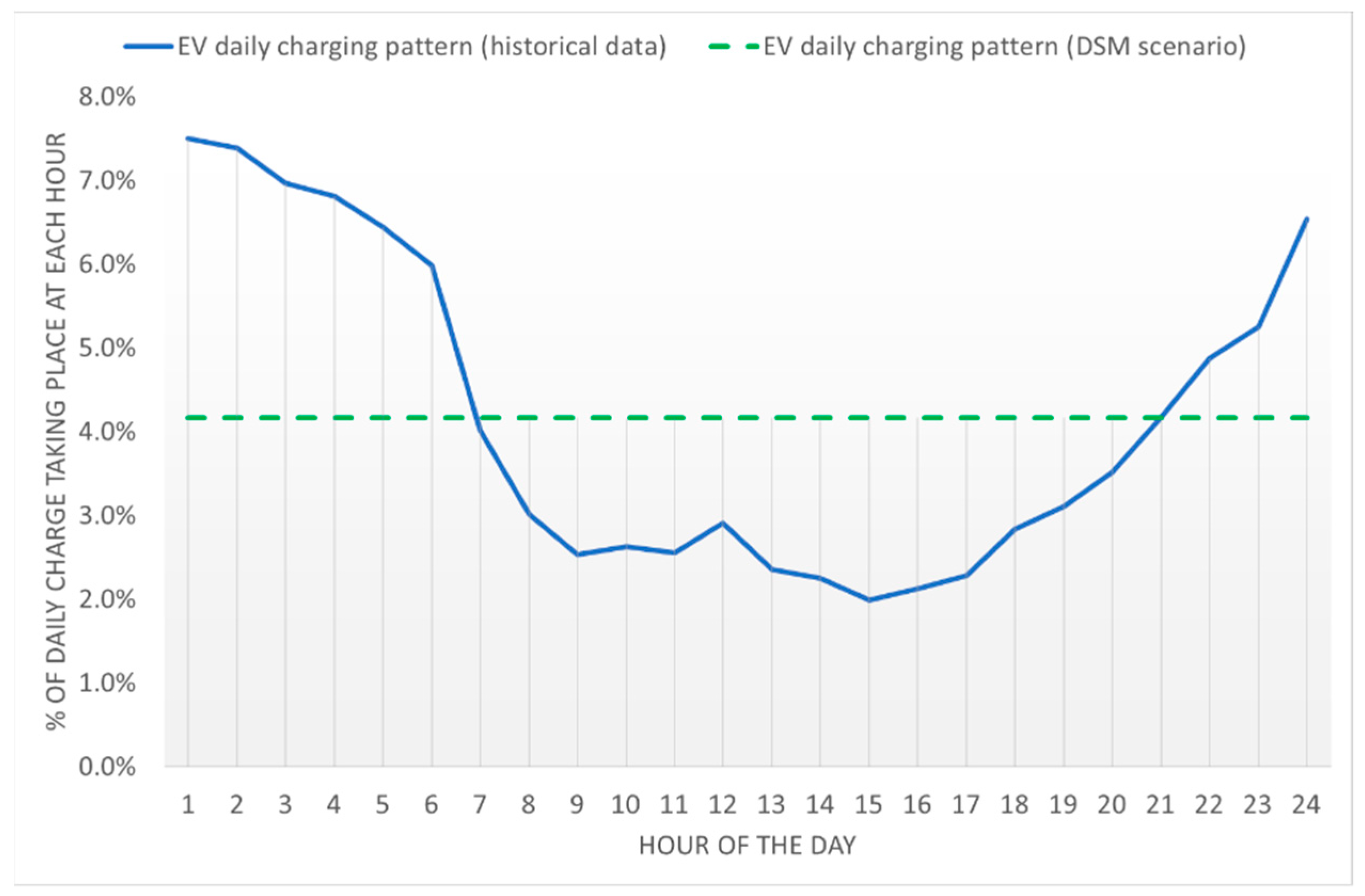
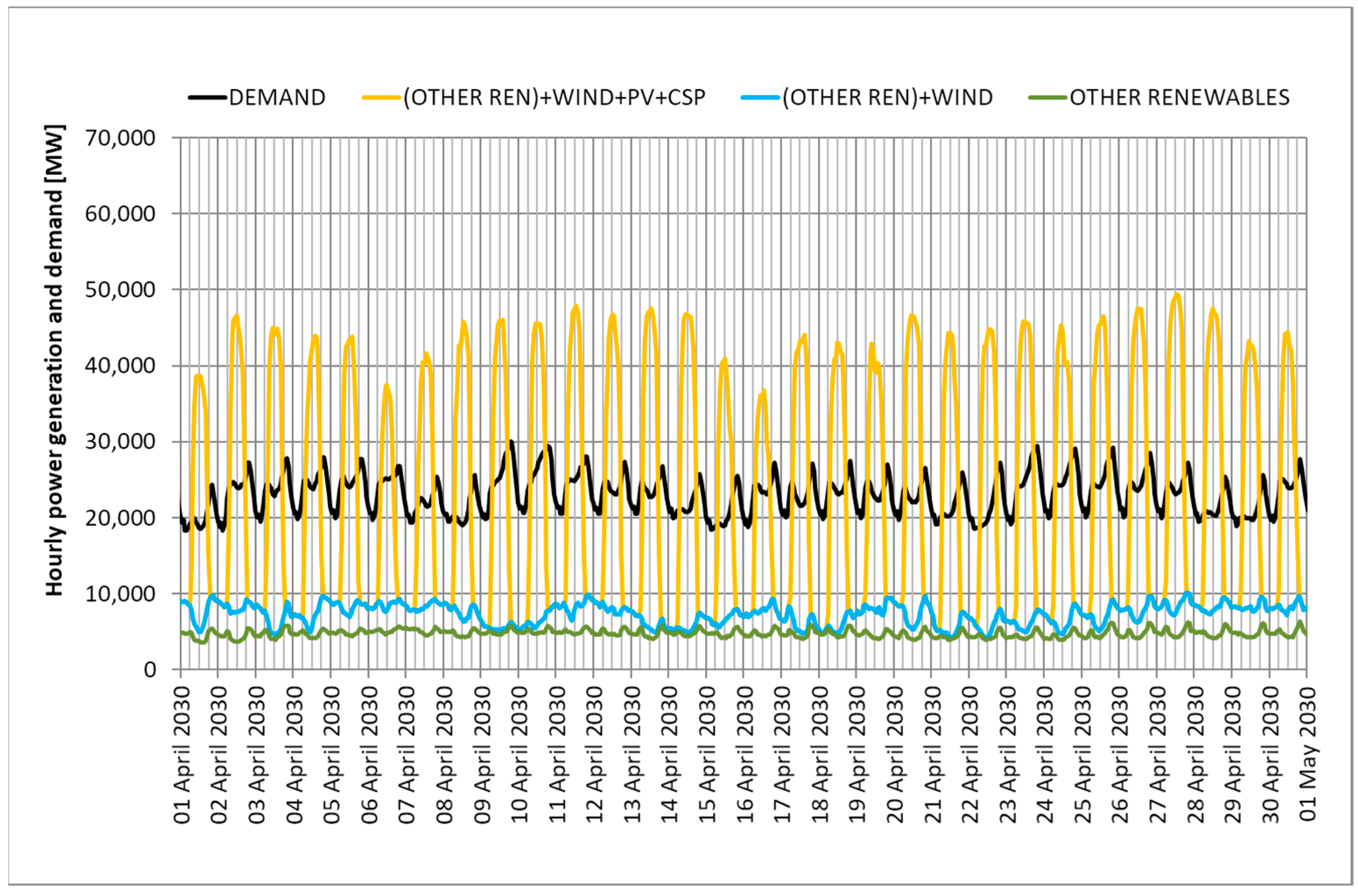

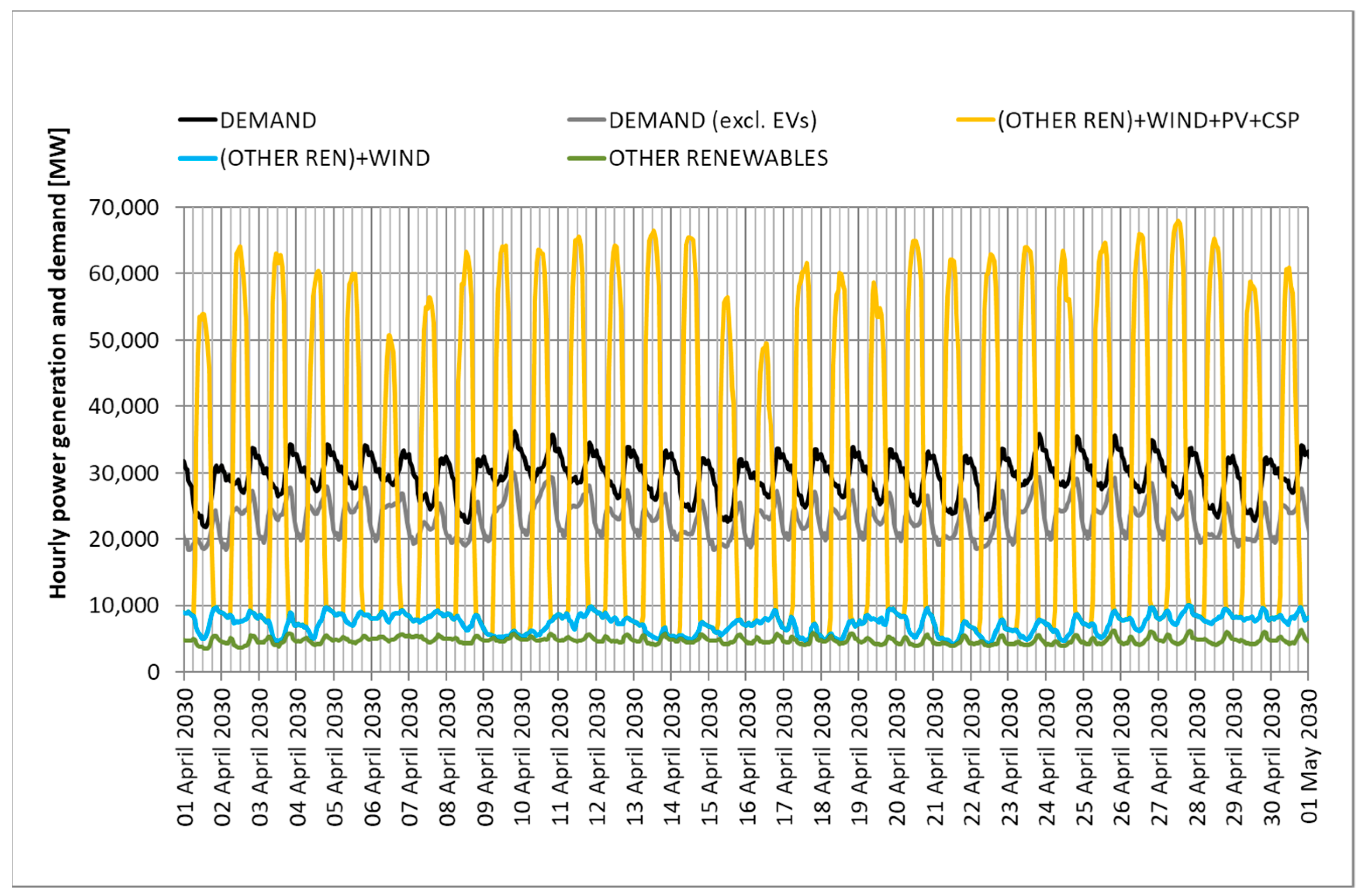

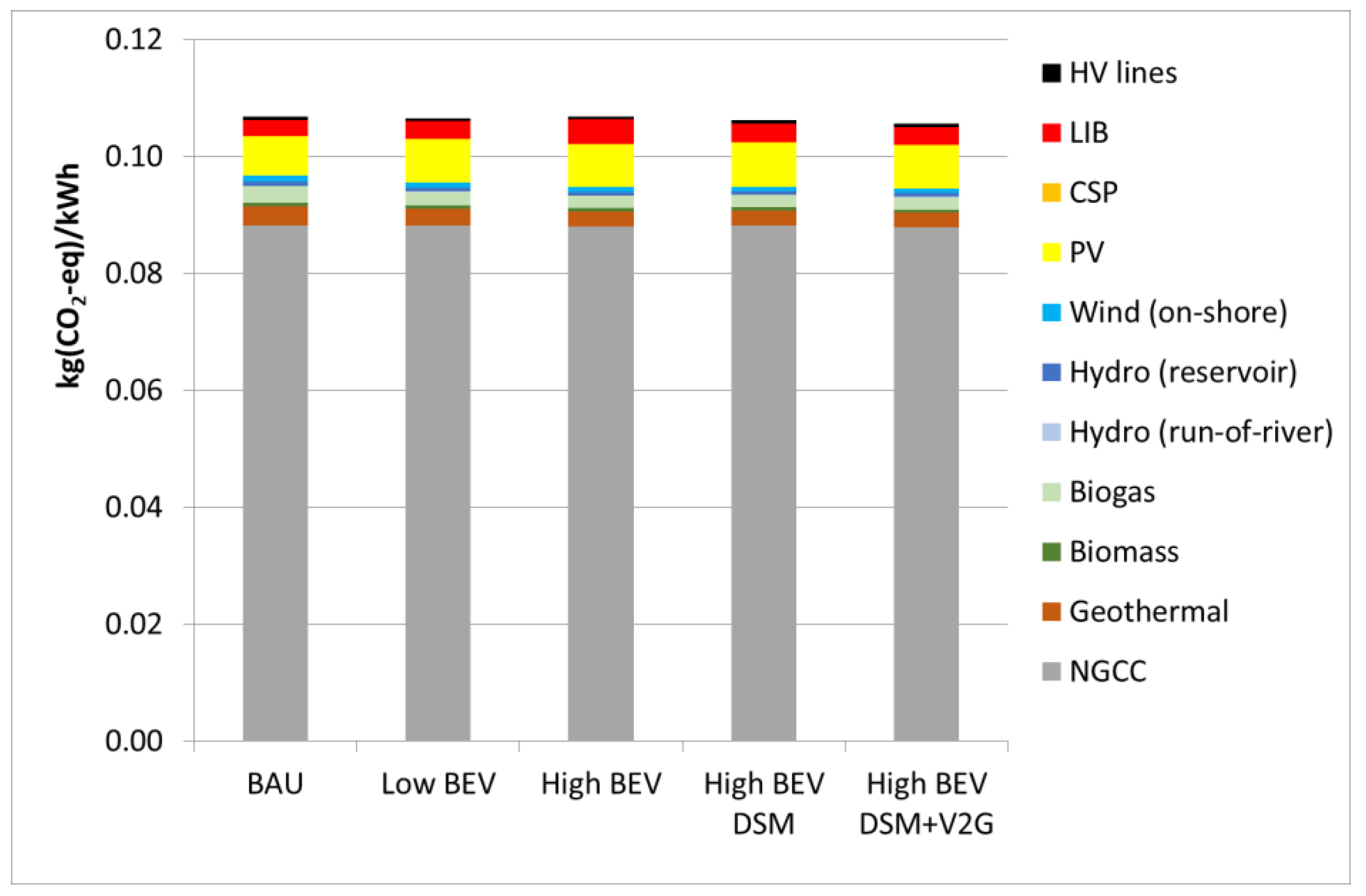
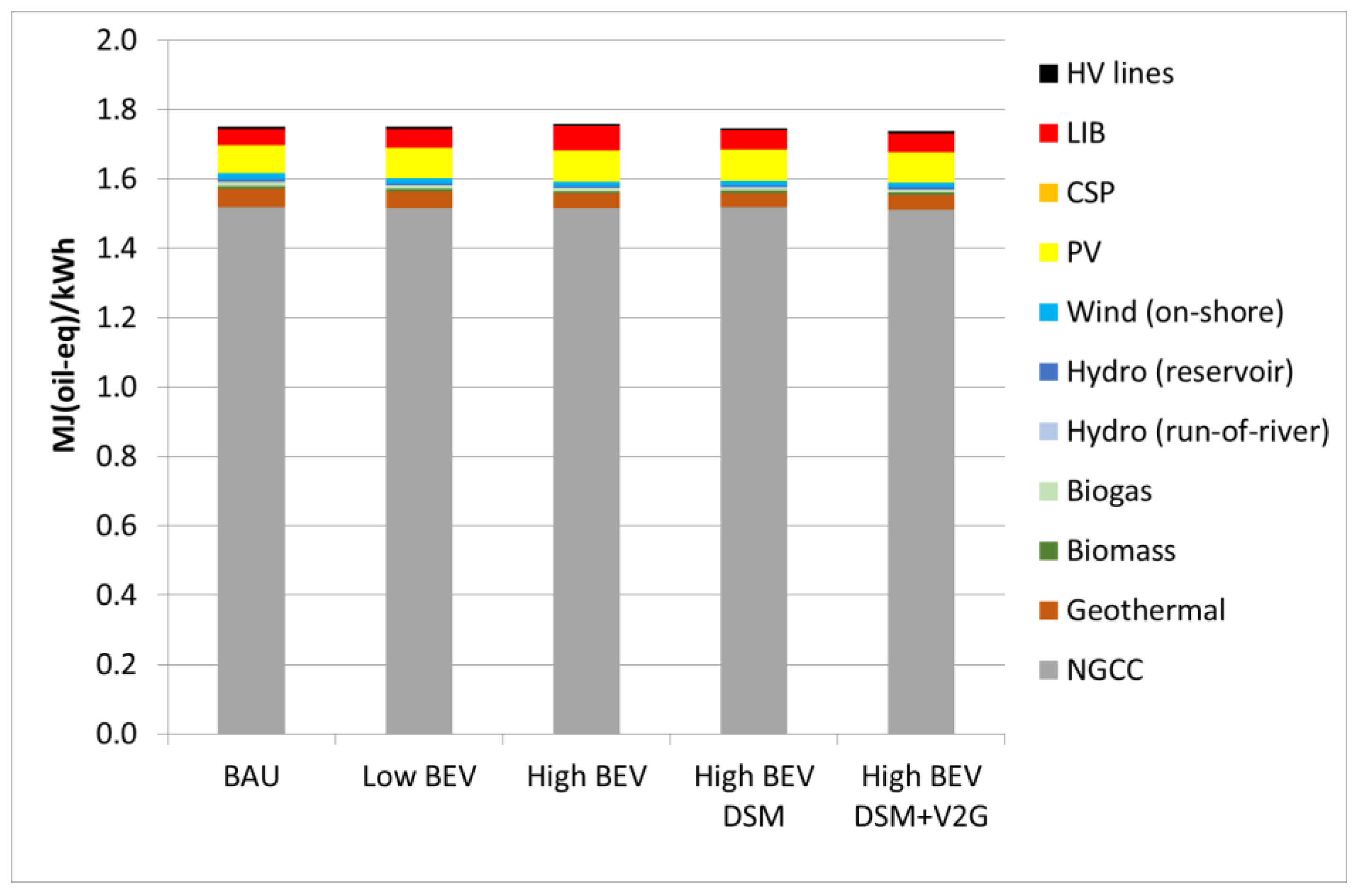
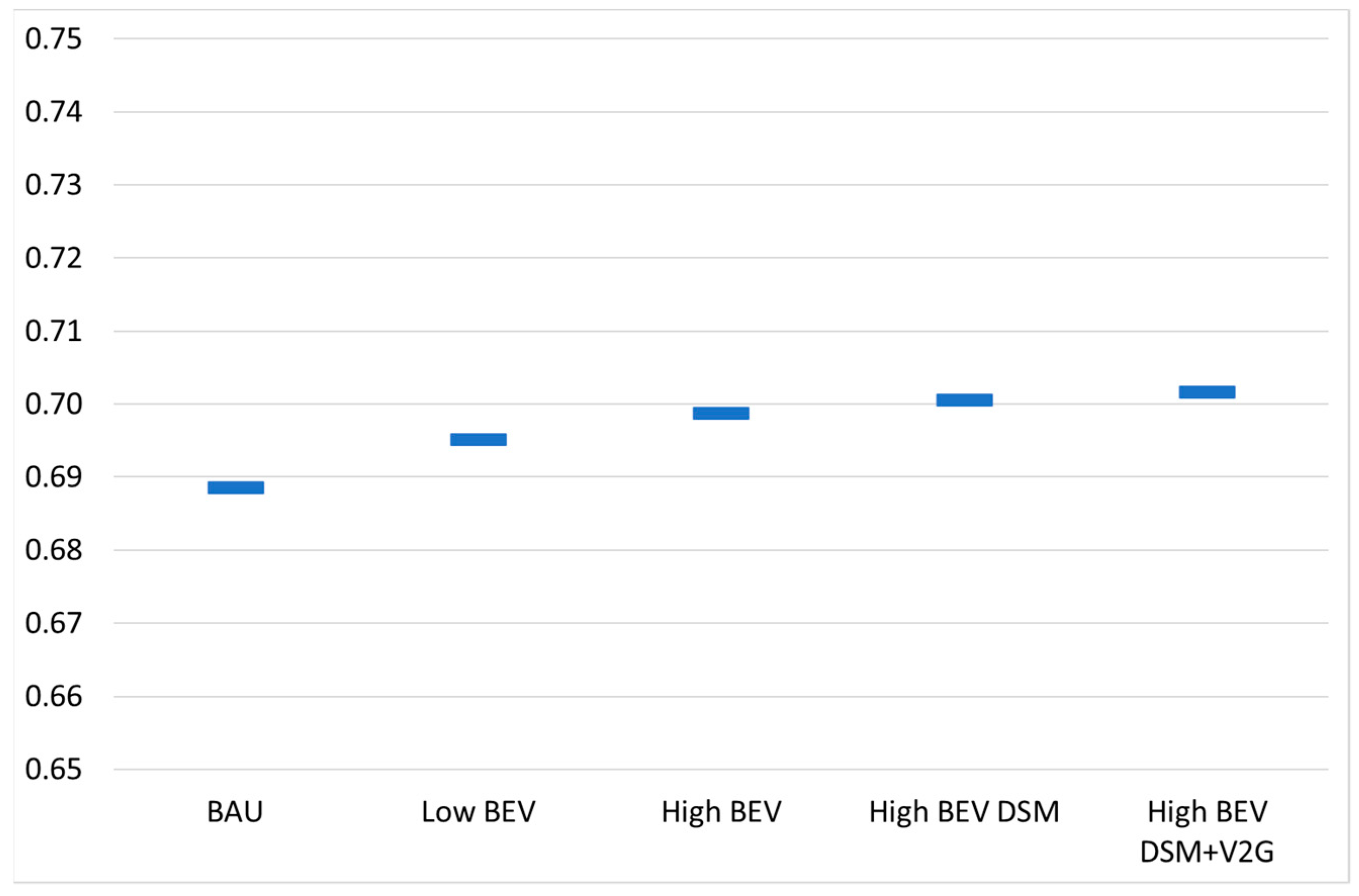
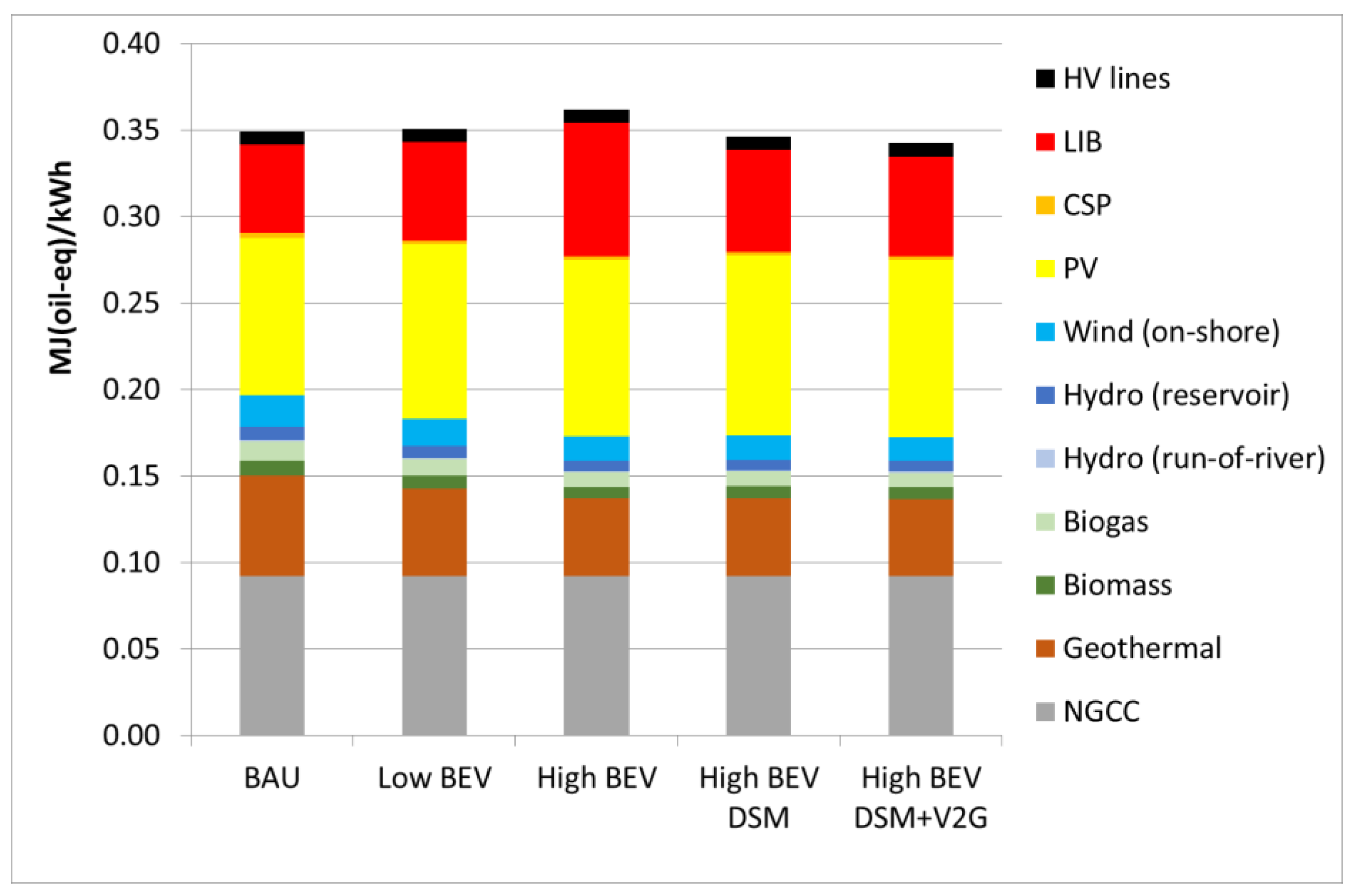

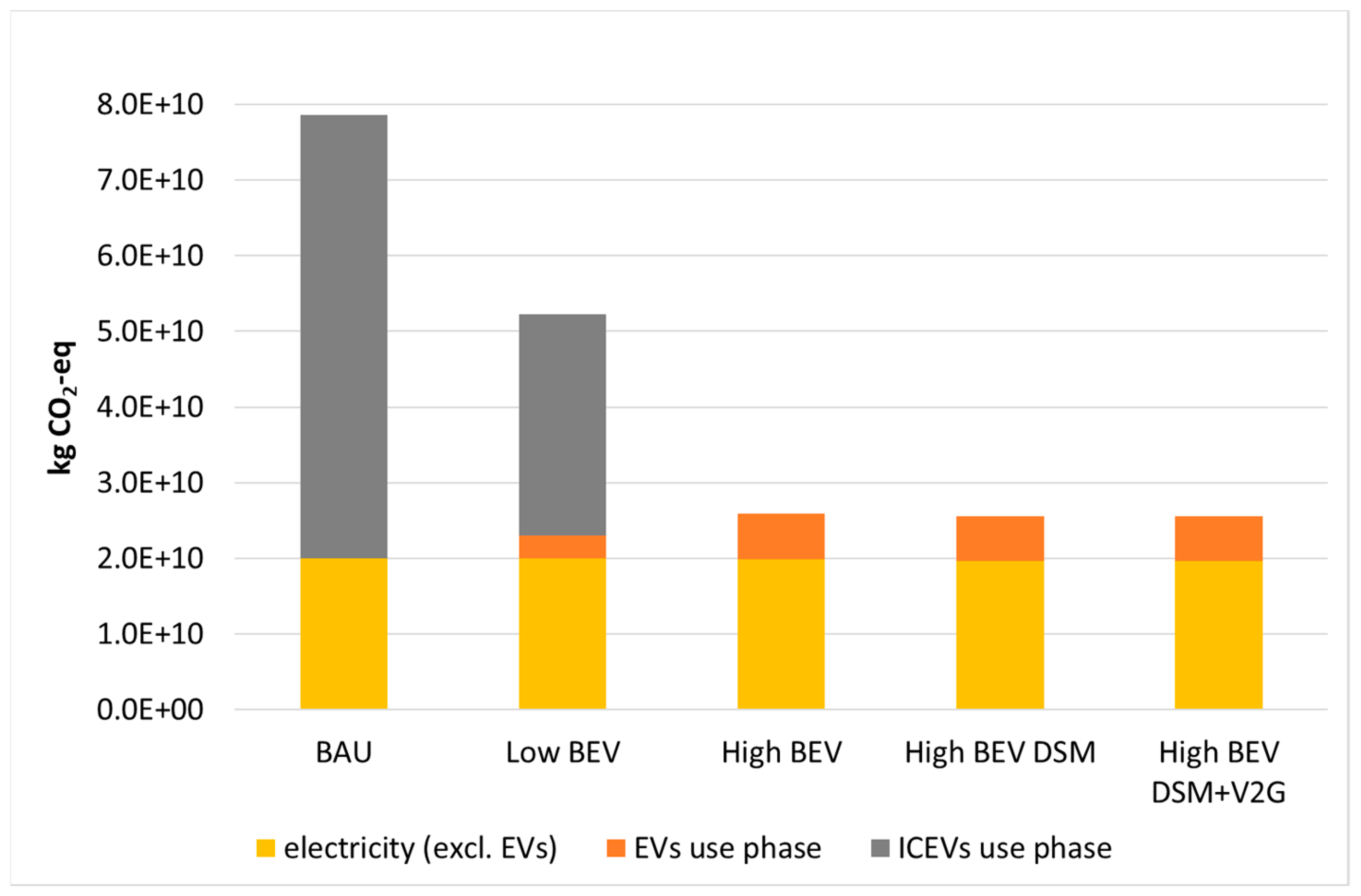
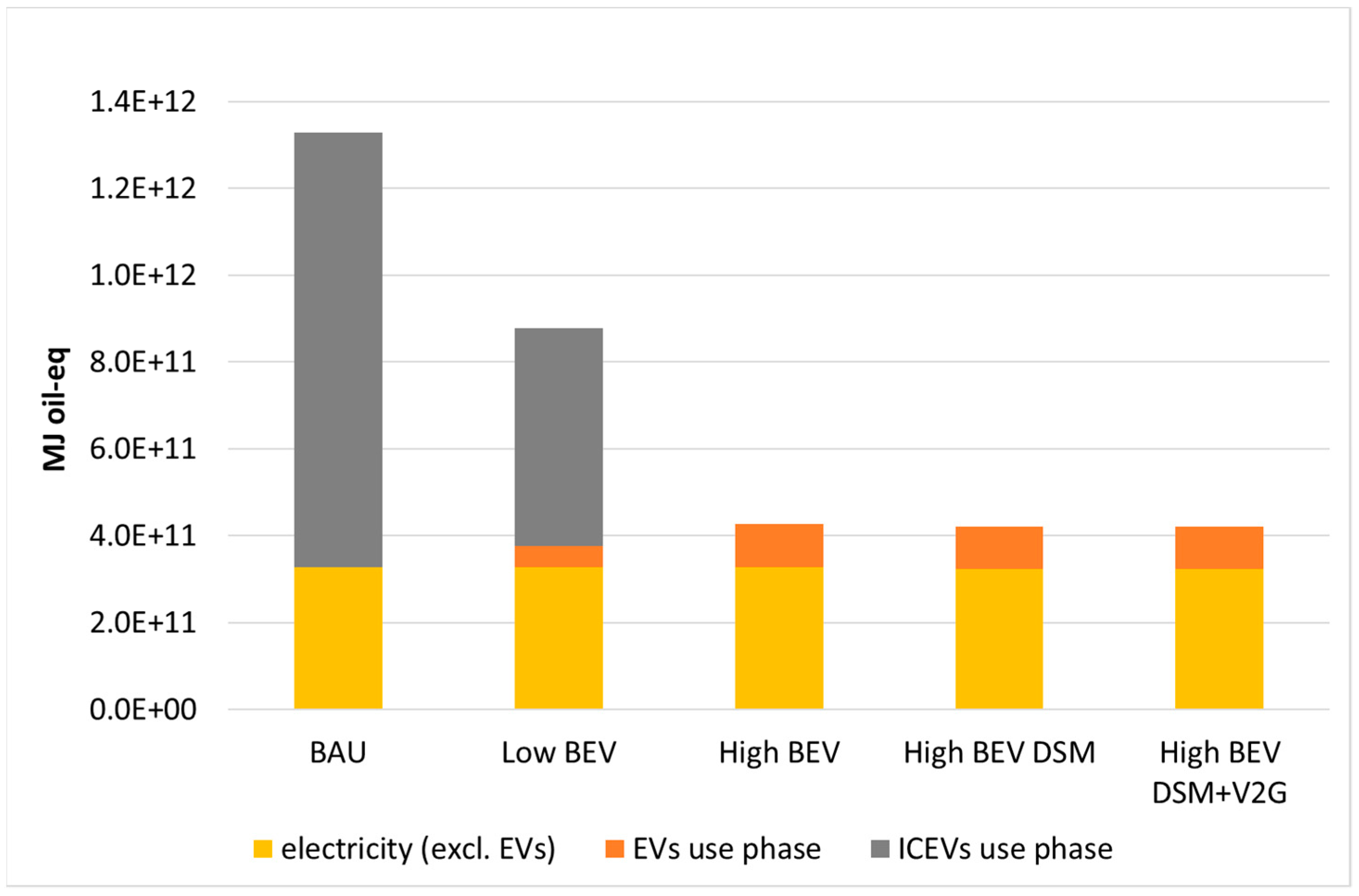
| Scenario | BEV Fleet (n. of Units) | Total Annual Electricity Demand (GWh) | PV Installed Power (MW) | Purpose-Built LIB Storage (h of Storage) | Purpose-Built LIB Storage (MWh of Storage Capacity) | V2G Storage (MWh of Storage Capacity) | % VRE Curtailment | |
|---|---|---|---|---|---|---|---|---|
| 1 | BAU | 0 | 226,342 | 42,857 | 6 | 154,285 | 0 | 2.5% |
| 2 | Low BEV | 5,000,000 | 254,545 | 53,305 | 6 | 191,898 | 0 | 4.5% |
| 3 | High BEV | 10,000,000 | 282,749 | 63,646 | 8 | 305,500 | 0 | 2.0% |
| 4 | High BEV DSM | 10,000,000 | 282,749 | 64,606 | 6 | 232,582 | 0 | 4.4% |
| 5 | High BEV DSM + V2G | 10,000,000 | 282,749 | 63,646 | 6 | 229,126 | 76,374 | 2.0% |
| Technology | BAU | Low BEV | High BEV | High BEV DSM | High BEV DSM + V2G |
|---|---|---|---|---|---|
| PV | 52% | 56% | 59% | 58% | 59% |
| NGCC | 20% | 20% | 20% | 20% | 20% |
| CSP | 1% | 1% | 1% | 1% | 1% |
| Geothermal | 4% | 4% | 3% | 3% | 3% |
| Biomass | 1% | 1% | 1% | 1% | 1% |
| Biogas | 1% | 1% | 1% | 1% | 1% |
| Hydro (run-of-river) | 2% | 1% | 1% | 1% | 1% |
| Hydro (reservoir) | 11% | 9% | 8% | 8% | 8% |
| Wind (on-shore) | 8% | 7% | 6% | 7% | 6% |
Publisher’s Note: MDPI stays neutral with regard to jurisdictional claims in published maps and institutional affiliations. |
© 2021 by the authors. Licensee MDPI, Basel, Switzerland. This article is an open access article distributed under the terms and conditions of the Creative Commons Attribution (CC BY) license (https://creativecommons.org/licenses/by/4.0/).
Share and Cite
Raugei, M.; Peluso, A.; Leccisi, E.; Fthenakis, V. Life-Cycle Carbon Emissions and Energy Implications of High Penetration of Photovoltaics and Electric Vehicles in California. Energies 2021, 14, 5165. https://doi.org/10.3390/en14165165
Raugei M, Peluso A, Leccisi E, Fthenakis V. Life-Cycle Carbon Emissions and Energy Implications of High Penetration of Photovoltaics and Electric Vehicles in California. Energies. 2021; 14(16):5165. https://doi.org/10.3390/en14165165
Chicago/Turabian StyleRaugei, Marco, Alessio Peluso, Enrica Leccisi, and Vasilis Fthenakis. 2021. "Life-Cycle Carbon Emissions and Energy Implications of High Penetration of Photovoltaics and Electric Vehicles in California" Energies 14, no. 16: 5165. https://doi.org/10.3390/en14165165
APA StyleRaugei, M., Peluso, A., Leccisi, E., & Fthenakis, V. (2021). Life-Cycle Carbon Emissions and Energy Implications of High Penetration of Photovoltaics and Electric Vehicles in California. Energies, 14(16), 5165. https://doi.org/10.3390/en14165165










